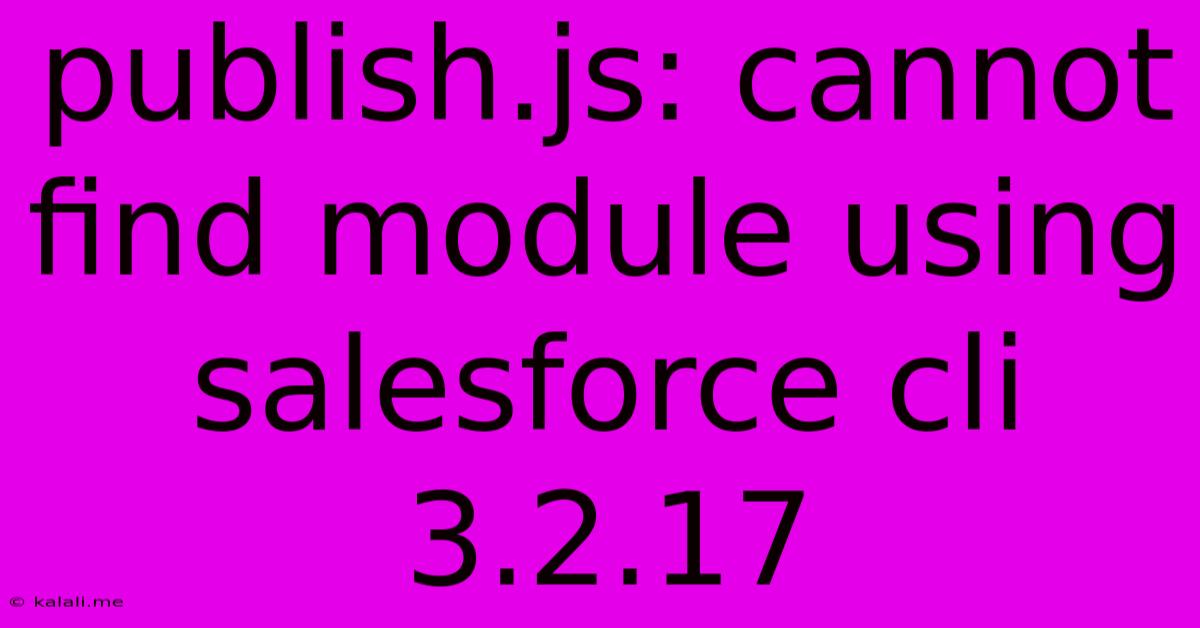Publish.js: Cannot Find Module Using Salesforce Cli 3.2.17
Kalali
May 23, 2025 · 4 min read

Table of Contents
Publish.js: Cannot Find Module Using Salesforce CLI 3.2.17
Encountering the dreaded "Cannot find module 'publish.js'" error when using the Salesforce CLI (version 3.2.17 or similar)? You're not alone. This frustrating issue often stems from misconfigurations within your Salesforce project or inconsistencies with your Node.js environment. This comprehensive guide will walk you through troubleshooting and resolving this problem, ensuring a smooth deployment process.
Meta Description: Troubleshoot and fix the "Cannot find module 'publish.js'" error in Salesforce CLI (version 3.2.17 and above). This guide provides detailed solutions for resolving this common deployment issue.
This error typically arises during the deployment phase using sfdx force:source:push or similar commands. The publish.js module is integral to the Salesforce CLI's deployment process, and its absence indicates a broken link in your project setup. Let's explore the most common causes and their respective solutions.
Understanding the Error
Before diving into solutions, it's crucial to grasp the root of the problem. The error message "Cannot find module 'publish.js'" signifies that the Salesforce CLI cannot locate the necessary JavaScript file responsible for managing the deployment process. This file isn't directly part of your project code; rather, it's a component within the Salesforce CLI's internal workings. Therefore, the problem lies not in your code, but in the CLI's environment or configuration.
Common Causes and Solutions
Here are the most frequent culprits leading to this error and effective troubleshooting steps:
1. Incorrect Project Setup or Missing Dependencies:
- Problem: Your Salesforce project might be improperly structured, lacking the essential folders and files expected by the CLI. Or, Node.js dependencies, crucial for the CLI's functionality, may be missing or outdated.
- Solution:
- Verify Project Structure: Ensure your project follows the standard Salesforce DX project structure. This usually includes a
force-appdirectory withmain,aura,lwcetc. subfolders. Check your project's root directory for this structure. - Update Node.js and npm/yarn: Update your Node.js and npm (or yarn) to their latest versions. Outdated package managers can lead to dependency conflicts. Use the commands
npm install -g npm@latestand/ornpm install -g node@latest(or the equivalent yarn commands). - Reinstall Salesforce CLI: Try reinstalling the Salesforce CLI completely to ensure a clean installation.
- Check
package.json(if applicable): If you're using a custom package, ensure that all dependencies in yourpackage.jsonfile are properly listed and installed. Runnpm installoryarn installto install any missing dependencies.
- Verify Project Structure: Ensure your project follows the standard Salesforce DX project structure. This usually includes a
2. Corrupted Salesforce CLI Installation:
- Problem: A corrupted or incomplete installation of the Salesforce CLI can prevent it from accessing necessary modules.
- Solution: Completely uninstall the Salesforce CLI and reinstall it from the official Salesforce website (though we cannot provide a direct link here, per the instructions). Follow the official installation guide for your operating system.
3. Environment Variable Issues:
- Problem: Sometimes, environment variables crucial for the CLI's operation might be misconfigured or missing.
- Solution: Double-check your environment variables related to Salesforce, especially
SFDX_PATHor any custom variables configured for your project.
4. Conflicting Node.js Versions:
- Problem: Using multiple versions of Node.js simultaneously can create conflicts, leading to module resolution issues.
- Solution: Utilize a version manager like nvm (Node Version Manager) to manage different Node.js versions effectively. Isolate your Salesforce projects to a specific, compatible Node.js version.
5. Permissions Problems:
- Problem: Insufficient file system permissions can prevent the CLI from accessing needed files.
- Solution: Ensure the user running the Salesforce CLI has sufficient read and write permissions in all the relevant project directories.
6. Proxy Issues:
- Problem: If you are behind a corporate proxy, the CLI might have trouble downloading necessary modules.
- Solution: Configure the proxy settings for your Salesforce CLI either via environment variables or the CLI's configuration settings.
Debugging Tips
If you've tried the above solutions and still face the error, try these debugging techniques:
- Check the CLI Logs: The Salesforce CLI usually logs detailed information about errors. Examine the logs to identify specific error messages.
- Simplify Your Project: Temporarily remove components from your project to isolate the source of the problem. If the error disappears after removing a specific component, it might point to the problematic area.
- Create a New Project: Create a new Salesforce DX project from scratch. Deploying to this new project can help isolate whether the issue stems from your existing project's configuration.
By systematically following these troubleshooting steps, you'll dramatically increase your chances of resolving the "Cannot find module 'publish.js'" error and successfully deploying your code to Salesforce. Remember to always check for the latest Salesforce CLI releases and Node.js updates to maintain a stable development environment.
Latest Posts
Latest Posts
-
Mother And I Or Mother And Me
Jul 18, 2025
-
How Many Oz In One Water Bottle
Jul 18, 2025
-
How Many Dimes In A 5 Roll
Jul 18, 2025
-
How Do You Say Basil In Spanish
Jul 18, 2025
-
How Many Cookies Are In A Dozen
Jul 18, 2025
Related Post
Thank you for visiting our website which covers about Publish.js: Cannot Find Module Using Salesforce Cli 3.2.17 . We hope the information provided has been useful to you. Feel free to contact us if you have any questions or need further assistance. See you next time and don't miss to bookmark.